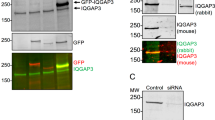Abstract
RAS oncogenes play a critical role in oncogenic transformation and metastases formation. Here we show that Ha-ras greatly stimulates spontaneous metastatic activity of transformed cells through the Ras/RalGDS/RalA intracellular signaling pathway. Introduction of RalA alone leads to a drastic increase of metastatic activity of transformed cells. We demonstrate that metastatic ability of cells could be dramatically enhanced by RalA stimulation or, conversely, hampered by RalA suppression. Furthermore, we found that during in vivo selection cells acquire high metastatic properties as a result of endogenous RalA activation. The ability of RalA to induce metastasis was demonstrated in spontaneously transformed as well as in virus transformed fibroblasts.
This is a preview of subscription content, access via your institution
Access options
Subscribe to this journal
Receive 50 print issues and online access
$259.00 per year
only $5.18 per issue
Buy this article
- Purchase on Springer Link
- Instant access to full article PDF
Prices may be subject to local taxes which are calculated during checkout




Similar content being viewed by others
References
Bernards R and Weinberg RA . (2002). Nature, 418, 823.
Bos JL . (1989). Cancer Res., 49, 4682–4689.
Chambers AF, Groom AC and MacDonald IC . (2002). Nat. Rev. Cancer, 2, 563–572.
Chambers AF and Tuck AB . (1993). Crit. Rev. Oncogenesis, 4, 95–114.
Chardin P and Tavitian A . (1986). EMBO J., 5, 2203–2208.
Chien Y and White MA . (2003). EMBO Rep., 4, 800–806.
Deichman GI, Kashkina LM, Mizenina OA, Gorojanskaya EG, Nikiforov MA, Gudkov AV, Dyakova NA, Komelkov AV, Prilutskaya MO, Kushlinsky NE and Tatosyan AG . (1996). Int. J. Cancer, 66, 747–752.
Deichman GI, Kashleva HA, Kluchareva TE and Matveeva VA . (1989a). Int. J. Cancer, 44, 908–910.
Deichman GI, Kluchareva TE, Matveeva VA, Kushlinsky NE, Bassalyk LS and Vendrov EL . (1989b). Int. J. Cancer, 44, 904–907.
Deichman GI, Topol LZ, Kluchareva TE, Matveeva VA, Zakamaldina TA, Uvarova EN and Tatosyan AG . (1992). Int. J. Cancer, 51, 903–908.
Downward J . (1998). Curr. Opin. Cell Biol., 10, 262–267.
Fidler IJ . (2003). Nat. Rev. Cancer, 3, 453–458.
Gildea JJ, Harding MA, Seraj MJ, Gulding KM and Theodorescu D . (2002). Cancer Res., 62, 982–985.
Hamad NM, Elconin JH, Karnoub AE, Bai W, Rich JN, Abraham RT, Der CJ and Counter CM . (2002). Genes Dev., 16, 2045–2057.
Joneson T, White MA, Wigler MH and Bar-Sagi D . (1996). Science, 271, 810–812.
Khosravi-Far R, White MA, Westwick JK, Solski PA, Chrzanowska-Wodnicka M, Van Aelst L, Wigler MH and Der CJ . (1996). Mol. Cell. Biol., 16, 3923–3933.
Malumbres M and Barbacid M . (2003). Nat. Rev. Cancer, 3, 459–465.
Miller MJ, Prigent S, Kupperman E, Rioux L, Park SH, Feramisco JR, White MA, Rutkowski JL and Meinkoth JL . (1997). J. Biol. Chem., 272, 5600–5605.
Mizenina O, Musatkina E, Yanushevich Y, Rodina A, Krasilnikov M, de Gunzburg J, Camonis JH, Tavitian A and Tatosyan A . (2001). J. Biol. Chem., 276, 34006–34012.
Moskalenko S, Henry D, Rosse C, Mirey G, Camonis J and White M . (2002). Nat. Cell Biol., 4, 66–72.
Pawlak G and Helfman DM . (2002). Mol. Biol. Cell, 13, 336–347.
Rodriguez-Viciana P, Warne PH, Khwaja A, Marte BM, Pappin D, Das P, Waterfield MD, Ridley A and Downward J . (1997). Cell, 89, 457–467.
Sprang SR . (1997). Annu. Rev. Biochem., 66, 639–678.
Suzuki J, Yamazaki Y, Li G, Kaziro Y and Koide H . (2000). Mol. Cell. Biol., 20, 4658–4665.
Topol LZ, Kisseljova NP, Gutierrez ML, Deichman GI, Musatkina EA, Shtutman MS, Zakamaldina TZ, Blair DG and Tatosyan AG . (1993). Mol. Carcinogen, 8, 167–176.
Urano T, Emkey R and Feig LA . (1996). EMBO J., 15, 810–816.
Ward Y, Wang W, Woodhouse E, Linnoila I, Liotta L and Kelly K . (2001). Mol. Cell. Biol., 21, 5958–5969.
Webb CP, Van Aelst L, Wigler MH and Woude GF . (1998). Proc. Natl. Acad. Sci. USA, 95, 8773–8778.
White MA, Vale T, Camonis JH, Schaefer E and Wigler MH . (1996). J. Biol. Chem., 271, 16439–16442.
Yamazaki Y, Kaziro Y and Koide H . (2001). Biochem. Biophys. Res. Commun., 280, 868–873.
Yu Y and Feig LA . (2002). Oncogene, 21, 7557–7568.
Acknowledgements
We thank J Downward and H Koide for provision of Ha-Ras and RalA mutant containing vectors, A Tavitian, G Deichman, B Kopnin and O Mizenina for support and fruitful discussion and N Isachenko for technical assistance. This study was supported by the Russian National Foundation for Basic Research, Grant No. 02-04-48626.
Author information
Authors and Affiliations
Corresponding author
Rights and permissions
About this article
Cite this article
Tchevkina, E., Agapova, L., Dyakova, N. et al. The small G-protein RalA stimulates metastasis of transformed cells. Oncogene 24, 329–335 (2005). https://doi.org/10.1038/sj.onc.1208094
Received:
Revised:
Accepted:
Published:
Issue Date:
DOI: https://doi.org/10.1038/sj.onc.1208094
Keywords
This article is cited by
-
The role of RAS effectors in BCR/ABL induced chronic myelogenous leukemia
Frontiers of Medicine (2013)
-
Different metastasis promotive potency of small G-proteins RalA and RalB in in vivo hamster tumor model
Cancer Cell International (2011)
-
The human Rgr oncogene is overexpressed in T-cell malignancies and induces transformation by acting as a GEF for Ras and Ral
Oncogene (2011)
-
Alteration in protein expression in estrogen receptor alpha-negative human breast cancer tissues indicates a malignant and metastatic phenotype
Clinical & Experimental Metastasis (2010)
-
SV40 small T antigen and PP2A phosphatase in cell transformation
Cancer and Metastasis Reviews (2008)



